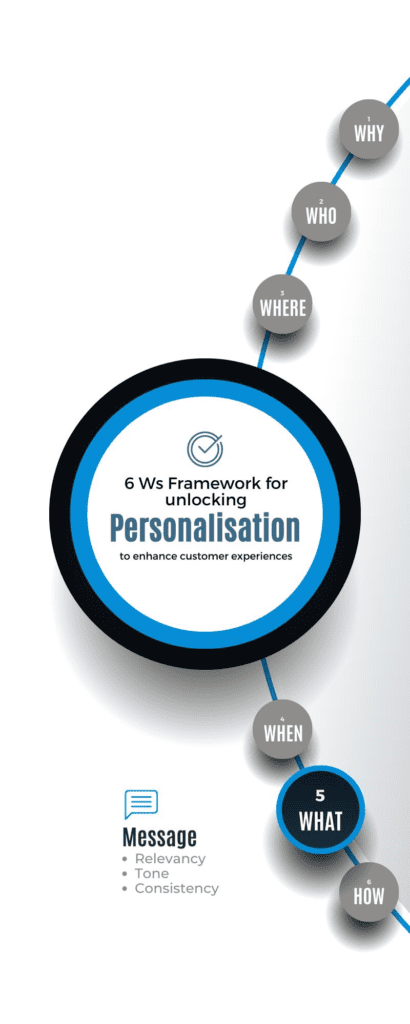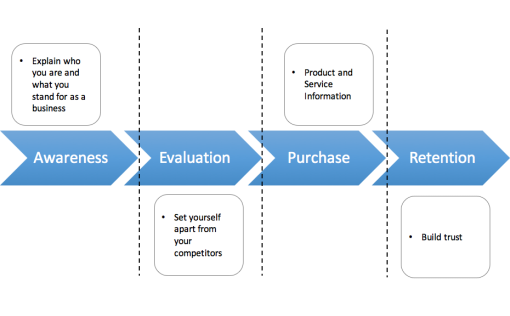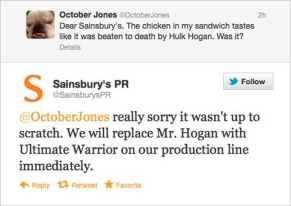I must admit that writing this particular article has been challenging for me. It pushed me beyond my comfort zone, which usually revolves around analytics, Experience Optimisation, campaign strategies, and data-driven stories. In my quest for knowledge, I enrolled in a couple of online courses related to the topic.
During my research, I came across several courses that sent follow-up emails after completion. One email, in particular, stood out as the digital marketing team behind it seemed to have put in the effort. They had a clear objective (the Why?), chose email as the communication channel (the Where?), and segmented recipients effectively (the Who?). Intrigued, I eagerly read the follow-up email.

However, to my disappointment, the email was poorly crafted and failed to impress me. It left me feeling somewhat annoyed, and as a result, I’ve decided not to engage further. This experience highlights the importance of the What of Personalisation. Even with a well-defined objective and appropriate segmentation, if the content and execution fall short, it can significantly impact the success of a campaign.
So far this series has covered how data can be used to identify right objective, audience, time and place to present personalised experience as part of Personalisation campaign planning.
Answering last two questions of What and How deals with actually presenting the experience. Most experts will tell you there is little distinction between the two — and in fact these two aspect are on a continuum. For me, What defines the actual content itself while How tells the way content is presented. So ‘get 25% off this summer’ is What. Presenting this message using a Homepage Hero banner is the How.
Content is the key message you wish to deliver to your target audience, providing them with a personalised experience. As accurately summarised by Joe Pulizzi, the founder of Content Marketing Institute, content should be both relevant and consistent, ultimately motivating profitable customer action. In today’s digital landscape, consumers anticipate content that resonates with their interests and preferences. If your brand fails to deliver such personalised content, there is a high likelihood that they will gravitate towards competitors who do. It is evident which of the two examples shared above aligns more closely with Joe’s expectations.
Breaking WHAT Into Parts:
Personalised content is comprised of 2 parts and as a marketer we need to consider both while planning a campaign:
- Personalised part — this part changes for individuals or audience-segments such as name, % of discount, post-code etc.
- Complementary part — this is rest of the message which creates a wrapper around Personalised part.
Examples
Some examples of personalised content are with Personalised part highlighted in bold
- Personalised offer: “Hi Trisha, you are now eligible for 20% to buy your favourite sunglasses”
- Product/Service recommendation on the basis of already known data-points: “Next time why not use our Mobile app to pay your bill even faster”
- Announcements: “5G broadband available in Shoreditch starting next month. Find out more”
The 3 Aspects
Answering What requires to understand following 3 aspects of your personalisation campaign:
- Relevancy: Message being relevant to customer’s profile, current context and your brand
- Tone: Content alignment to the marketing-journey-step
- Consistency: Consistent message across various touch-points

1. Relevancy
Relevancy is a vast and significant topic, with extensive literature dedicated to its exploration. I highly encourage you to delve into articles and books on the subject to gain a comprehensive understanding. However, as a starting point, I offer a three-step breakdown of relevancy that I recommend for your initial exploration and further development as you expand your knowledge:
1.1 Relevant to Customer-profile:
This is normally first part of personalised content which is mainly a result of complex modelling and predictive algorithms working on customer’s profile data to decide which offer or message will be most suitable for target audience. Big data teams work tirelessly to automate these tasks and vendors like Pega can support the whole process. The end result is a relevant offer or a list of offers — and companies that automate this process by integrating their customer and marketing data platforms are more successfully able to present the right offer to right audience. This allows brands to shape their customers’ decision journeys, deepen their relationships, and gain a distinct competitive advantage.
Companies that don’t have luxury of such a process, can still personalise their content that, though generic in nature, still makes your customers feel that they are being considered as individuals such as recommendations starting with ‘Just for you’. Termed as Barnum effect and more such tricks are explained in articles that explain impact of Psychology on decision-making — please explore if you haven’t already (start with this article by AB Tasty).
1.2 Relevant to Customer Journey Stage:
Surely you have seen multiple versions of customer-lifecycle journey, divided into multiple stages. I use one below and overlay with what type of message I should chose depending upon the stage — quite clear I believe.

1.3 Relevant to your brand
Importantly, the message has to be relevant to your own brand as well. I was part of a conversation recently where it was asked not to use words like ‘amazing’ and ‘mega’ as it doesn’t fit brand-language. This is absolutely fair and that’s where marketers should seek support from other teams like Legal and Copywriters to avoid irrelevant or low-quality content, that can harm your brand-value. More on this when we talk about Tone in next section.
2. Tone
This is the second part of personalised content i.e. the wrapper around personalised part. While creating message your personalisation campaign intends to pass, consider which type of language should your brand use to address the audience. Are there any specific words or vocabulary that should be used? Such decisions set the stage for using right tone for presenting personalisation message.
Tone of the message has an important role in this decision making and my 2 examples above are testament to that. A bad tone can easily be a put-off, resulting into an intrusive or annoying experience.
A simple approach is to put yourself in shoes of your customers and ask whether the tone of message is inspiring or off-putting (or even desperate). If I refer to customer-journey image above, simple 2 rules to use:
- If your message is for Awareness and Evaluation stages, keep it more informal, less intrusive and less direct. For example “Your favourite retail brand is treating its loyal customers with up to 20% discount this Easter”
- Be more direct for remaining 2 stages e.g. you can use personal information but still ensure to keep it human. “Martin, as a gesture to thank you for your 5 years long relationship with us, here’s 20% discount coupon when you buy any Men’s accessories”
Companies like Persado use psychology and AI to fine tune tone of personalisation messages, covering all channels and can reduce guess-work that you as a marketer need to do as part of every campaign you execute.
Additionally, you can also consider combination of following 4 aspects to decide tone to make your message more engaging — as described by Lauren Johnson from iThinkMedia in her blog:
- Humorous or serious?
- Formal or casual?
- Respectful or irreverent?
- Emotive or matter-of-fact?
Here’s an example of how Sainsbury used humour effectively in a Twitter response and I am sure this will make you smile and if doesn’t there are more in this The Drum article.

3. Consistency
Today’s customer interacts with a brand using multiple touch-points and this makes ‘content-consistency’ a crucial aspect while planning a personalisation campaign. In absence of data-integration within these touch-points, it’s very easy to end up showing 2 different offers on a single product to the same customer at different touch-points — say 10% online discount and 15% in an email. This will lead to lack of trust in brand and biased towards a specific touchpoint — it’s not uncommon to come across brands where customers first go online to find special offers and then call telesales to find better deals. As it involves multiple channels, work with representatives from these teams on a strategic decision to have a consistent message across touch-points — an example is investing in a centralised, multi-channel Campaign management tool like Adobe Campaign or Percolate.
How Marketers can participate here — by plotting customer-journey for a campaign. Digital Analytics data can play a pivotal role here to understand the most common paths customers take and therefore plan campaign accordingly. For instance, if majority of your customers are landing on Homepage after clicking on an offer in monthly newsletter, you should plan to show consistent message on Homepage as well (or least make sure Homepage experience is not inconsistent with the offer customer just saw).
Another input from Marketers is to define “How many times before showing the next message”. Did you get annoyed by being chased with the same promotion across every website you browsed after you shown interest in a pair of sunglasses? Expect the same from your customers. The answer here is setting up Frequency-capping which preferably should be defined at cross-channel level.
Please note that consistent doesn’t mean same. Your tone of message for the same offer can vary depending upon the customer-touch-point.
Takeaway
- Adapt the message tone based on the marketing funnel stage to ensure customers remain engaged and don’t feel overwhelmed.
- Ensure that personalised content remains consistent across various customer touch-points while being cautious not to overwhelm customers with excessive outreach attempts.
- Engage the appropriate teams, including Legal, to ensure that messages are not only relevant to your audience but also align with your brand values and guidelines.
- Leverage experimentation effectively to test and optimise different messages.
In the next and the last post, I’ll share the some tips on how to deliver a personalised experience — answering HOW?





